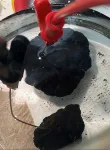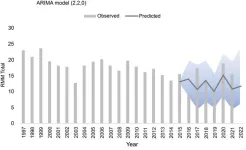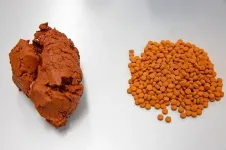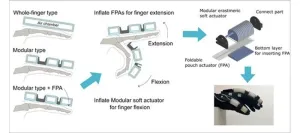(Press-News.org)
An international team of researchers, including a Northwestern University chemist, has discovered that metallic minerals on the deep-ocean floor produce oxygen — 13,000 feet below the surface.
The surprising discovery challenges long-held assumptions that only photosynthetic organisms, such as plants and algae, generate Earth’s oxygen. But the new finding shows there might be another way. It appears oxygen also can be produced at the seafloor — where no light can penetrate — to support the oxygen-breathing (aerobic) sea life living in complete darkness.
The study will be published Monday (July 22) in the journal Nature Geoscience.
Andrew Sweetman, of the Scottish Association for Marine Science (SAMS), made the “dark oxygen” discovery while conducting ship-based fieldwork in the Pacific Ocean. Northwestern’s Franz Geiger led the electrochemistry experiments, which potentially explain the finding.
“For aerobic life to begin on the planet, there had to be oxygen, and our understanding has been that Earth’s oxygen supply began with photosynthetic organisms,” said Sweetman, who leads the Seafloor Ecology and Biogeochemistry research group at SAMS. “But we now know that there is oxygen produced in the deep sea, where there is no light. I think we, therefore, need to revisit questions like: Where could aerobic life have begun?”
Polymetallic nodules — natural mineral deposits that form on the ocean floor — sit at the heart of the discovery. A mix of various minerals, the nodules measure anywhere between tiny particles and an average potato in size.
“The polymetallic nodules that produce this oxygen contain metals such as cobalt, nickel, copper, lithium and manganese — which are all critical elements used in batteries,” said Geiger, who co-authored the study. “Several large-scale mining companies now aim to extract these precious elements from the seafloor at depths of 10,000 to 20,000 feet below the surface. We need to rethink how to mine these materials, so that we do not deplete the oxygen source for deep-sea life.”
Geiger is the Charles E. and Emma H. Morrison Professor of Chemistry at Northwestern’s Weinberg College of Arts and Sciences and member of the International Institute for Nanotechnology and the Paula M. Trienens Institute for Energy and Sustainability.
‘Something ground-breaking and unthought-of’
Sweetman made the discovery while sampling the seabed of the Clarion-Clipperton Zone, a mountainous submarine ridge along the seafloor that extends nearly 4,500 miles along the north-east quadrant of the Pacific Ocean. When his team initially detected oxygen, he assumed the equipment must be broken.
“When we first got this data, we thought the sensors were faulty because every study ever done in the deep sea has only seen oxygen being consumed rather than produced,” Sweetman said. “We would come home and recalibrate the sensors, but, over the course of 10 years, these strange oxygen readings kept showing up.
“We decided to take a back-up method that worked differently to the optode sensors we were using. When both methods came back with the same result, we knew we were onto something ground-breaking and unthought-of.”
Hidden ‘geobatteries’ at play
In summer 2023, Sweetman contacted Geiger to discuss possible explanations for the oxygen source. In his previous work, Geiger found that rust, when combined with saltwater, can generate electricity. The researchers wondered if the deep-ocean’s polymetallic nodules generated enough electricity to produce oxygen. This chemical reaction is part of a process called seawater electrolysis, which pulls electrons out of water’s oxygen atom.
To investigate this hypothesis, Sweetman shipped several pounds of the polymetallic nodules, which were collected from the ocean floor, to Geiger’s laboratory at Northwestern. Sweetman also visited Northwestern last December, spending a week in Geiger’s lab.
Just 1.5 volts — the same voltage as a typical AA battery — is enough to split seawater. Amazingly, the team recorded voltages of up to 0.95 volts on the surface of single nodules. And when multiple nodules clustered together, the voltage can be much more significant, just like when batteries are connected in a series.
“It appears that we discovered a natural ‘geobattery,’” Geiger said. “These geobatteries are the basis for a possible explanation of the ocean’s dark oxygen production.”
A new consideration for miners
The researchers agree that the mining industry should consider this discovery before planning deep-sea mining activities. According to Geiger, the total mass of polymetallic nodules in the Clarion-Clipperton Zone alone is enough to meet the global demand for energy for decades. But Geiger looks to mining efforts in the 1980s as a cautionary tale.
“In 2016 and 2017, marine biologists visited sites that were mined in the 1980s and found not even bacteria had recovered in mined areas,” Geiger said. “In unmined regions, however, marine life flourished. Why such ‘dead zones’ persist for decades is still unknown. However, this puts a major asterisk onto strategies for sea-floor mining as ocean-floor faunal diversity in nodule-rich areas is higher than in the most diverse tropical rainforests.”
The study, “Evidence of dark oxygen production at the abysmal seafloor,” was supported by Nauru Ocean Resources Inc., a subsidiary of The Metals Company Inc.
END
About The Study: The results of this cohort study suggest that prenatal cannabis use was associated with several adverse maternal health outcomes during pregnancy. Continued research is needed to understand whether characteristics of prenatal cannabis use (e.g., dose, mode, and timing) moderate these associations.
Corresponding Author: To contact the corresponding author, Kelly C. Young-Wolff, Ph.D., M.P.H., email kelly.c.young-wolff@kp.org.
To access the embargoed study: Visit our For The Media ...
About The Study: The findings of this study suggest that sexual and gender minority adults in the U.S. have a disproportionate prevalence of epilepsy. The reasons for this disparity are likely complex and may be associated with biological and psychosocial determinants of health unique to this population; as such, these individuals are in need of protected access to medical care.
Corresponding Author: To contact the corresponding author, Emily L. Johnson, M.D., M.P.H., email ejohns92@jhmi.edu.
To access the embargoed study: Visit our For The Media website at this link https://media.jamanetwork.com/
(doi:10.1001/jamaneurol.2024.2243)
Editor’s ...
About The Study: In this randomized clinical trial, overground robot-assisted gait training using a wearable robot significantly improved gross motor function and gait pattern. This new torque-assisted wearable exoskeletal robot, based on assist-as-needed control, may complement standard rehabilitation by providing adequate assistance and therapeutic support to children with cerebral palsy.
Corresponding Author: To contact the corresponding author, Min-Keun Song, M.D., Ph.D., email drsongmk@chonnam.ac.kr.
To access the embargoed study: Visit our ...
What:
Sexual and gender minorities (SGM)—individuals who identify as gay, lesbian, bisexual, queer, transgender, non-binary, or gender-diverse—are twice as likely to report active epilepsy compared to non-SGM individuals, based on a National Institutes of Health (NIH) analysis of data from the population-based National Health Information Survey. “Active epilepsy” means a person has been diagnosed with epilepsy and has had more than one seizure in the past year or is currently taking anti-seizure medication.
This study suggests that epilepsy could be added to the growing ...
During the peak of the SARS-CoV-2 pandemic, there was an increase in maternal mortality in Chile. This is confirmed by a natural population experiment based on data from the Department of Health Statistics and Information (DEIS) of the Chilean Ministry of Health. The research was published in PLOS Global Public Health.
In a collaborative study, led by Professor Elard Koch, senior epidemiologist and founder of MELISA Institute (Chile), and conducted with a team of researchers from the Universidad Católica Sedes Sapientiae (Peru), the Pontificia Universidad ...
A University of Virginia School of Medicine scientist and other top experts from around the world have developed the first comprehensive guidelines for reporting cutting-edge “precision medicine” research in a bid to improve patient care and health equity for people everywhere.
Precision medicine aims to tailor treatments to individual patients to get the best possible outcomes. It does this by considering many different factors specific to the patient, such as the patient’s genetics, environment, lifestyle and more. But until now there have been no standardized guidelines for reporting precision ...
Research Highlights:
Two new, basic research studies in rodents (mice and rats) analyzed the impacts that alcohol may have on the heart.
In a mouse study, abnormal heart rhythms that can occur after a pattern of repeated simulation of binge drinking may be related to a spike in a stress protein found in the heart. Researchers tested a heart protective molecule to reduce the stress protein spike and the resulting irregular heart rhythms.
In a study using rats that lacked estrogen production to simulate human menopause, alcohol exposure resulted ...
A technology has been developed to decompose refrigerants, a greenhouse gas 1,300 times more potent than carbon dioxide, using challenging-to-handle industrial waste.
Dr. Ryi, Shin-kun’s research team at the Hydrogen Convergence Materials Lab of the Korea Institute of Energy Research (KIER) has successfully developed a catalyst from industrial waste known as 'red mud,' a byproduct of aluminum production. This catalyst can decompose HFC-134a refrigerant, commonly used in household appliances like air conditioners and refrigerators, with an efficiency of 99%.
* Red Mud: An industrial byproduct remaining after extracting aluminum ...
Tim Rademacher is taking on a sweet new role at the University of Vermont—as the new Scientific Director of UVM’s Proctor Maple Research Center (PMRC). The PMRC is a field research station of the Department of Plant Biology at the University of Vermont, and is the oldest and most renowned maple science research centers in the world. Since 1947 it has produced cutting edge research on maple, supported maple sugar producers, and bolstered maple syrup production in Vermont—and globally.
“I'm very excited to join PMRC with its rich history and its excellent work that has really pushed the industry in the past, says Rademacher, who will start this fall. “I ...
Soft rehabilitation gloves have become popular tools for helping patients with hand function-related disabilities recover finger movement. These gloves often use soft pneumatic actuators that employ air pressure to generate movements. Despite significant design improvements in recent years, many available soft actuators have drawbacks in achieving bidirectional motion typical of finger joints—such soft actuators facilitate finger bending (or flexion) but not finger straightening (or extension).
A group of biomedical researchers from Chiba University successfully ...





